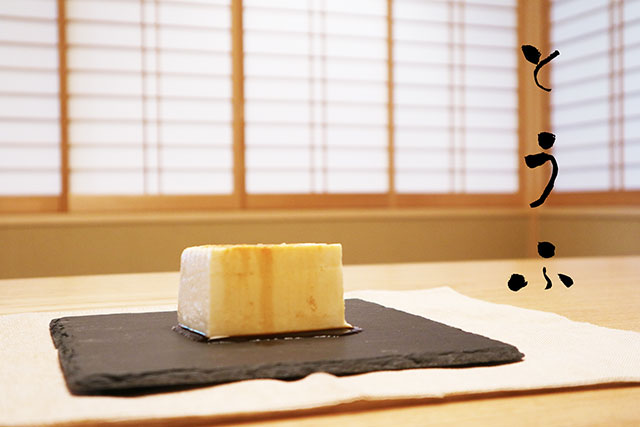
Staple of Japanese cuisine, tofu is extremely common in Japanese dishes, whether found cut into small cubes in miso soup or stirred with other ingredients or eaten raw straight from the package as is. From the mild plain flavor, tofu can be arranged in many styles and also be a substitute for meat. Nourishing and protein rich, it’s a good addition to any vegetarian or vegan meal too. Why not try tofu in your vegan & vegetarian lifestyle?
-
01
What is tofu?
![]()
Tofu, also called bean curd is a soft, relatively flavourless food product made from soybeans. It is an important source of protein in the cuisines of China, Japan, Korea and Southeast Asia. Tofu was first introduced to Japan by the “Kentoushi” (Japanese missions to Tang China ) who traveled between China and Japan during Nara period (710-784). However, there are no clear records for its evidence but a diary from Nara Kasuga Taisha Shrine did mentioned about an offering at the shrines’ altar which used tofu in 1183. This is probably the oldest document where tofu was recorded.
With more vegetarian diet known as “shojin” cuisine spread among the monks as part of their ascetic training where they abstain from eating meat or fish, tofu was highly prized as one of their choices for good source of protein. As time passed, tofu, which had been the food of monks, samurai families and nobilities, it began to spread into ordinary households during Edo period and thus, became the staple of Japanese cuisines.
Interesting trivia fact here is that the characters used to write tofu were different from the characters used today. It was written “唐符”instead of “豆腐”. However, both characters remind something of China. For example, the first character 唐(pronounced “to” as in toe like foot) means “Tang”, as in Tang Dynasty. And 腐used in the current version of tofu means “liquid objects are put together to turn solid” in Chinese. Since tofu came from Tang, China, it is obvious and understandable to see the characters used to write tofu resemble its origin. -
02
Types of Tofu
Silken? Firm tofu? Some may think the difference of those are using silk or cotton cloth in the manufacturing process but that assumption is totally wrong. Rather, it is categorized by its texture or consistency and depends on how “smooth” its finished touch is. The more water, the softer or “silkier” the tofu, and with less water, the tofu gets firmer. Most common types of tofu you will find in Japanese food would be kinu (silken) tofu and momen (firm) tofu, and processed tofu products such as yuba (tofu skin), tofu pasta and soy milk.
![]()
-
03
Kinu (Silken) Tofu
Just as popular as momen(firm) tofu, this tofu can be considered the “standard” Japanese tofu. It has the highest water content making it soft and smooth, best enjoyed in dishes that require little or no cooking. To appreciate its natural flavor, such Japanese dishes like hiyayakko (chilled tofu seasoned with soy sauce and garnished with freshly grate ginger and scallions) is highly recommended.
-
04
Momen (Firm) Tofu
The other main type of tofu, momen (firm) tofu has been favored in Japanese cuisine for a long time and has a slightly rough texture with cotton cloth or mold imprints typically remained due to being pressed with cotton cloth to remove excess water. Rather than enjoying its natural flavor like kinu (silken) tofu, because it is firmer, this type of tofu best suits cuisine that involves stirring. But of course, momen tofu can also be eaten as is, without heating or cooking, if you like it more chewy.
![]()
-
05
Oboro Tofu (Silken tofu curds)
In the shape of hazy full moon, oboro(hazy) tofu is simply tofu before being pressed and formed. Its soft and jelly like texture comes from its making process where when soy milk simmers over the stove, it curdles into a “cloud-like” consistency. Because it is served in a bowl, otherwise it is known as yose-tofu(寄せ豆腐). Yose(寄せ) means to serve in Japanese. On the other, if it's served in a basket(zaru), it's called zaru-tofu. Of all kinds of tofu, oboro tofu is the softest and eaten as is without cooking and its flavorful enough to eat with modest toppings like soy sauce and salt.
![]()
-
06
Yuba (tofu skin)
The chewy texture like that of a surface of a fresh mozzarella, yuba (tofu skin) is a by product of soy milk formed on the surface when heated, and are high in protein and low in calories, while boasting zero cholesterol.It’s sold both raw and dry and can be found in supermarkets and even in convenience stores.
-
07
Tofu Pasta/Soumen
Something light, refreshing and cheap sold around 200 yen, would be the tofu pasta/soumen. It may look like very thin noodles but actually these "noodles" are made out of tofu instead of wheat and flour. Soumen is a very thin Japanese noodle and because of its similarity in the appearance, tofu pasta is sold as tofu soumen (豆腐そう麺).
However, its dashi soup is usually made of bonito so if you can’t eat seafood, its best advised to take it out and eat it with something else.![]()
-
08
Soy Milk
One of non dietary substitute for cow’s milk is the soy milk made with either soybeans or soy protein isolate with high-quality protein. The taste may differ depending on the brands but typically mild and creamy flavor. It is sold from 100 yen most likely at any stores.
![]()
-
09
Hanpen(fish sausage) & Tofu
Especially if you are allergic to seafood and have special dietary requirements, don’t confuse hanpen (fish sausage) with tofu.
Hanpen is made by mixing white fish or shark meat with yamanoimo into a paste, placing it in molds and boiling or steaming it until hardens to a firm but soft texture. It may look like flat tofu but it's completely different, its fish sausage in short.![]()
-
10
Tofu Cooking Tips
![]()
Frozen tofu makes great tofu meat which is chewier, spongier and firmer than it was before. A great substitute for meat. The homemade tofu meat will give you a texture that isn’t too far from some of the meatless crumbles you can buy at the store, but it’s a bit lighter. So kinu (silken) or momen (firm) tofu, which is better when frozen? The answer would be momen(firm). Once the kinu tofu is frozen its smoothness is gone and turn into a chewy taste like that of yuba (tofu skin). Bu momen tofu keep its original taste regardless of frozen or refrigerated. Besides, the frozen tofu will soak up a marinade better. Enjoy tofu cooking!
The Tokyo Station Hotel
1-9-1 Marunouchi, Chiyoda-ku Tokyo

-










 Go here
Go here










